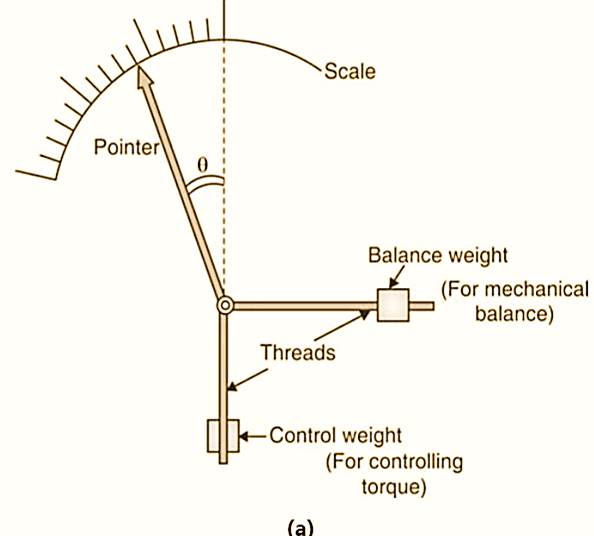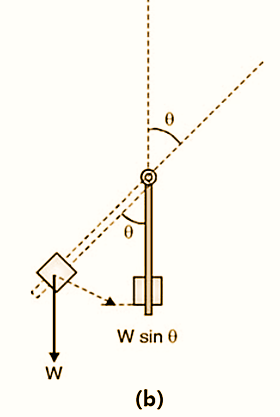The deflecting torque causes the pointer to deflect from zero position and it may attain any position on the scale. But it is desired that the proportional to the quantity attain any position deflection should to be measured. So controlling torque is essential.
Functions of Controlling Torque
- It produces an equal torque in opposite direction to deflecting torque. Thus the deflection is proportional to quantity under measurements.
- It brings back to pointer to zero position when deflecting torque becomes zero.
The pointer shows final steady state deflection when Controlling torque equals to the Deflecting torque, i.e.
\[{{T}_{C}}={{T}_{d}} \]
Torque to Weight Ratio (T/W Ratio) :
The moving system of measuring instrument should be light in weight. If it is heavy, it will produce more friction torque during deflection of the instrument and thus performance of the instrument is hampered. So if friction torque is large, the instrument may not show deflection for small magnitude quantities. i.e. its sensitivity is affected. If friction torque is negligible, the instrument can show appreciable deflection for small magnitude quantities.
\[\text{Hence the ratio = }\frac{\text{Deflecting torque}}{\text{Frictional torque}}\]
Since frictional torque depends on weight of moving system the ratio can be written as,
\[\frac{\text{Deflecting torque}}{\text{Weight of moving system}}=\frac{\text{Torque}}{\text{Weight}}=\frac{T}{W}\]
More is the \(\frac{T}{W}\) ratio, better is the performance of the instrument.
Methods of Providing Controlling Torque
Following methods are used to provide controlling torque :
- Spring control
- Gravity control
Spring Control

This method is commonly employed in indicating instruments. A spiral wound spring made up of phosphor bronze is attached to the spindle as shown in Fig. 1. One inner end of spring is attached to the spindle and outer end is attached to a fixed point or support on the instrument. A jewel screw is provided for adjustment of spring tension i.e. for adjusting controlling torque (Tc). The jewel screw is also operated for zero adjustment. In many indicating instruments, the spring is a current carrying member. i.e. it provides lead for incoming and outgoing current. The spring also produces controlling torque. So both electrical and mechanical properties of spring are important.
Desired properties of Spring
- It should be non magnetic.
- It should withstand mechanical vibrations.
- It should have low temperature coefficient of resistance (if it is a current carrying member).
- It should not deteriorate with time.
Phosphor bronze material is best suited for springs. The controlling torque.
\[{{T}_{c}}=k\theta \]
Where,
k – Spring constant
θ – Angular deflection of pointer in radian from zero position
The expression for controlling torque in terms of physical parameters of the spring is as follows :
\[{{T}_{c}}=\frac{Eb{{t}^{3}}}{12l}\theta \]
E – Young’s modulus of spring material in N/m2.
b – Width of spring in meter
t – Thickness of spring in meter
l – Length of spring in meter
θ – Angular deflection in rad
\[{{T}_{c}}=k\theta \] \[k=\frac{Eb{{t}^{3}}}{12l}\]
Where, k is spring constant.
Advantages of Spring Control
- Spring control is easy to apply.
- The spring material is non magnetic so it does not affect the operating flux.
- The position of instrument does not affect controlling torque. So instrument can be operated in horizontal or vertical position.
- It is light in weight so does not add to weight of the instrument.
- Cost is less.
- Tc = k θ so controlling torque equation is linear.
- Maintenance is easy.
- Adjustment of controlling torque is easy.
Disadvantages of Spring Control
- Deformation : If spring is stretched beyond its limit it may loose its elastic properties.
- If temperature variation is drastic, it will affect controlling torque.
Gravity Control


Figure 2.
It uses gravity force to produce controlling torque. Control weight and balancing weight are attached to the spindle as shown in figure 2. The balancing weight is provided for mechanical balance and for zero setting. The control and balancing weight are adjustable this can be taken towards the spindle or away from the spindle. Threads are provided for this purpose.
Controlling Torque = W Sinθ
Advantages of Gravity control
- No effect of temperature.
- Effective method of controlling torque.
- Adjustment can be done easily.
- Longer life.
Disadvantages of Gravity control
- It has to be used in vertical position only so suitable for vertically mounted instruments.
- Control weight adds to the weight of moving system. Costly.
- Longer life.
- Maintenance is complicated
Difference between Spring Control and Gravity Control
| Point of comparison | Spring control | Gravity control |
| Arrangement | Spring is attached to the pointer. | Control weight and balance weight and attached to the spindle. |
| Suitability | Can be used for vertical and horizontal mounted instruments. | Can be used only for vertically mounted instruments. |
| Equation for controlling torque | Tc = k θ | Tc = W sin θ |
| Scale of instrument | Uniform | Not uniform |
| Perfect levelling of instrument | Not required | required |
| Cost | Cheap | Costlier than spring control. |
| Adjustment | Easy (screw) is provided for adjustment | Some what difficult (control weight balance weight position is to be adjusted) |
| Effect of temperature variation | Controlling torque is affected | No effect |
| Aging effect | Yes | No |
| Maintenance work | Easy | Complicated than spring control. |
| Weight | Less | More |
| Space required | Less | More |